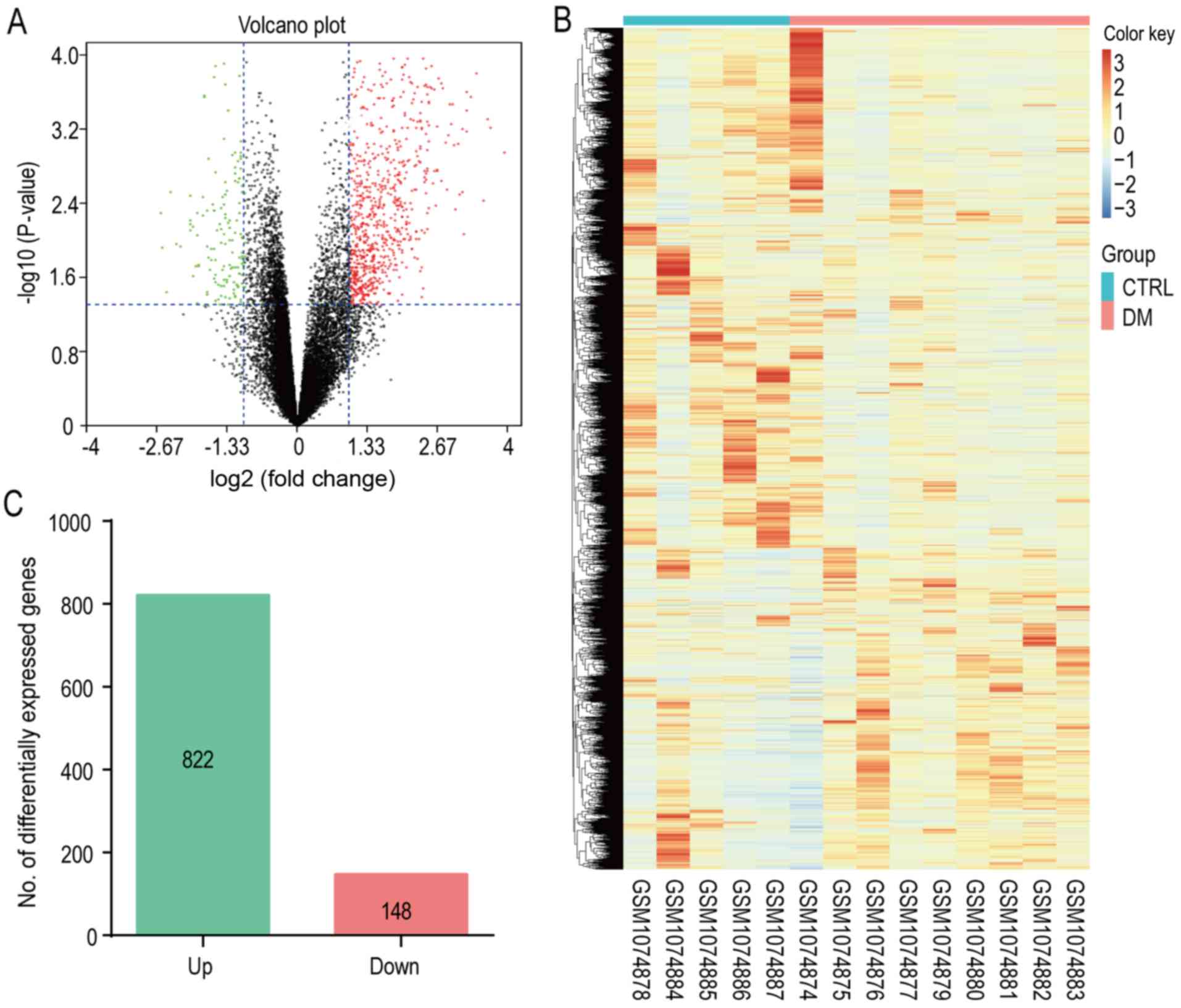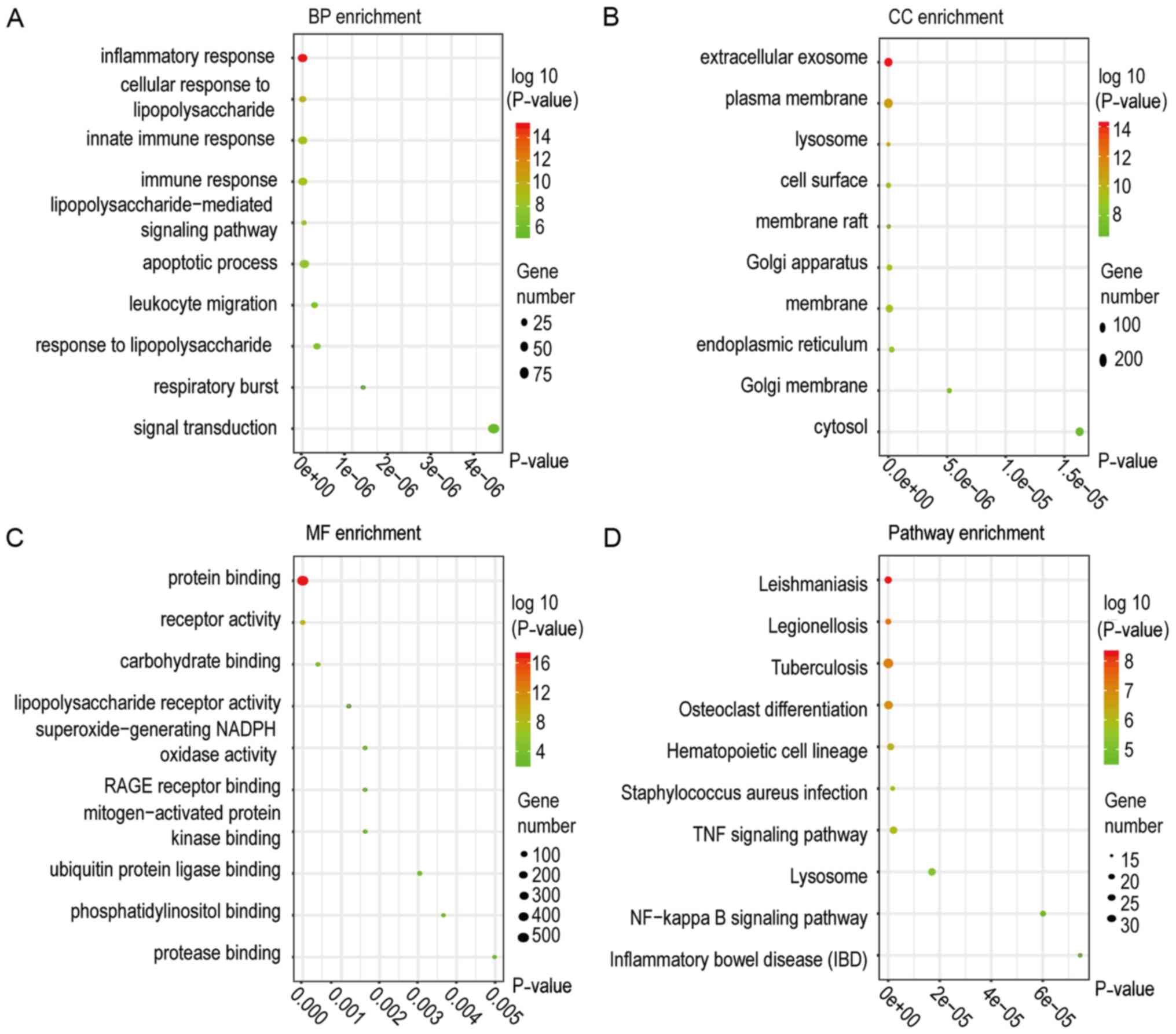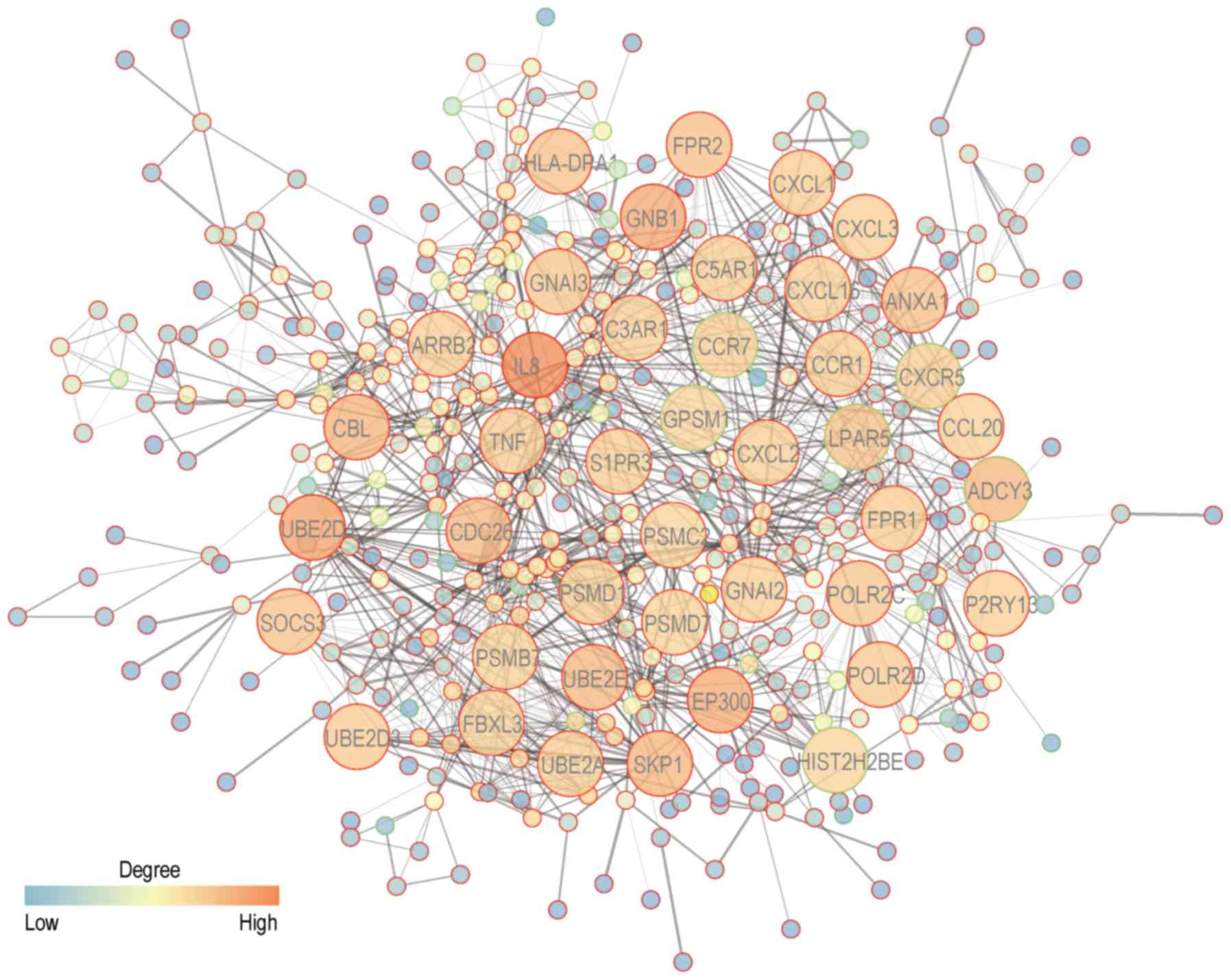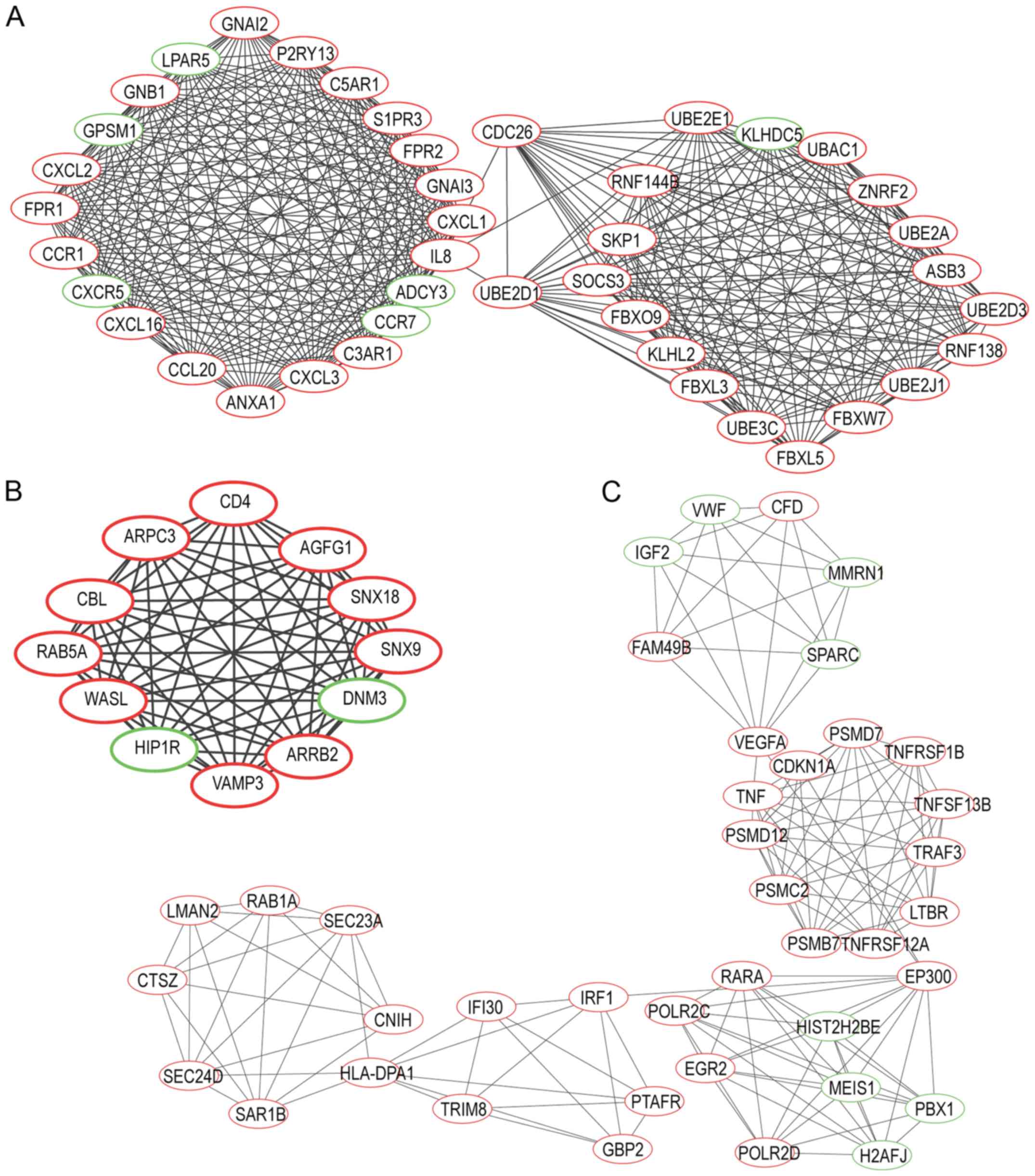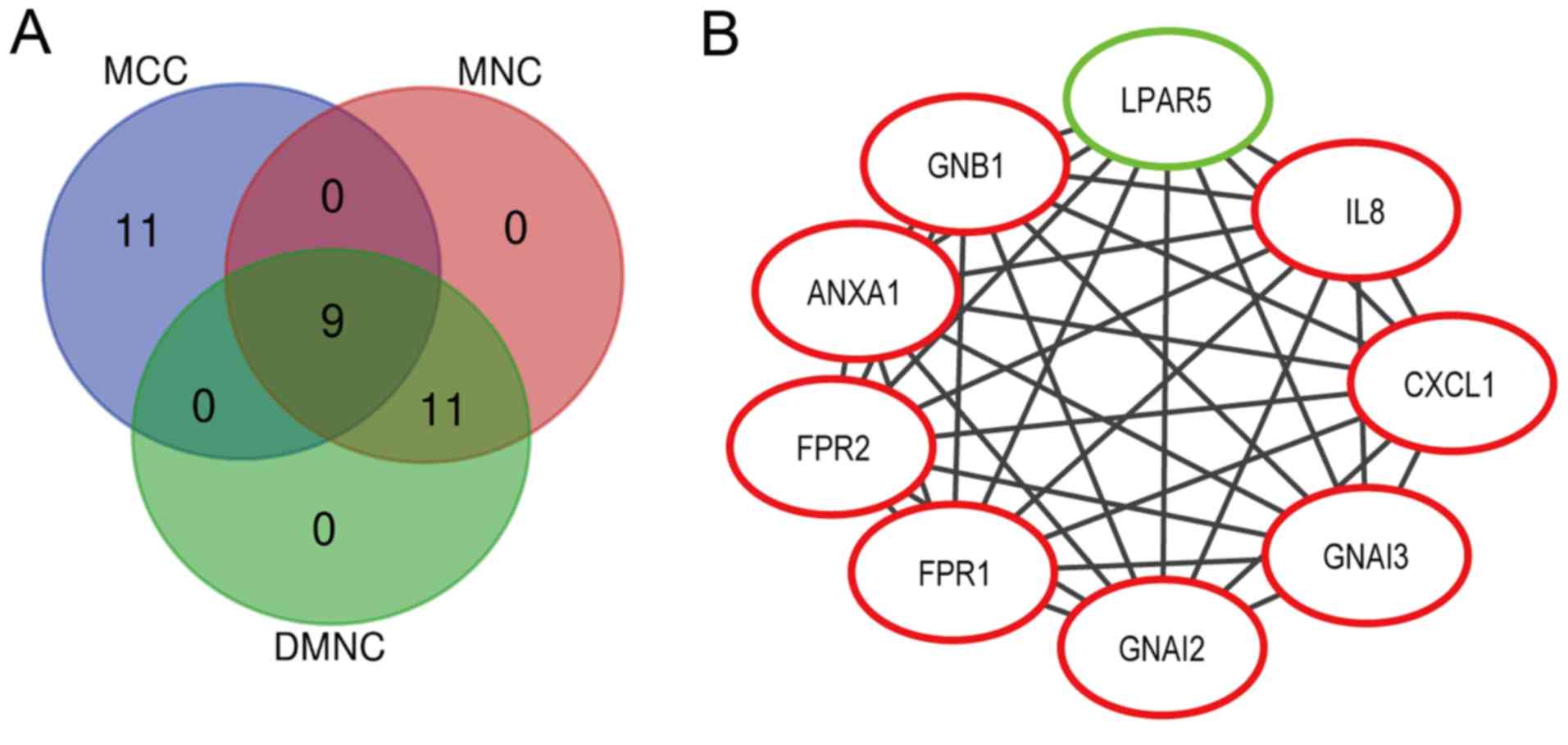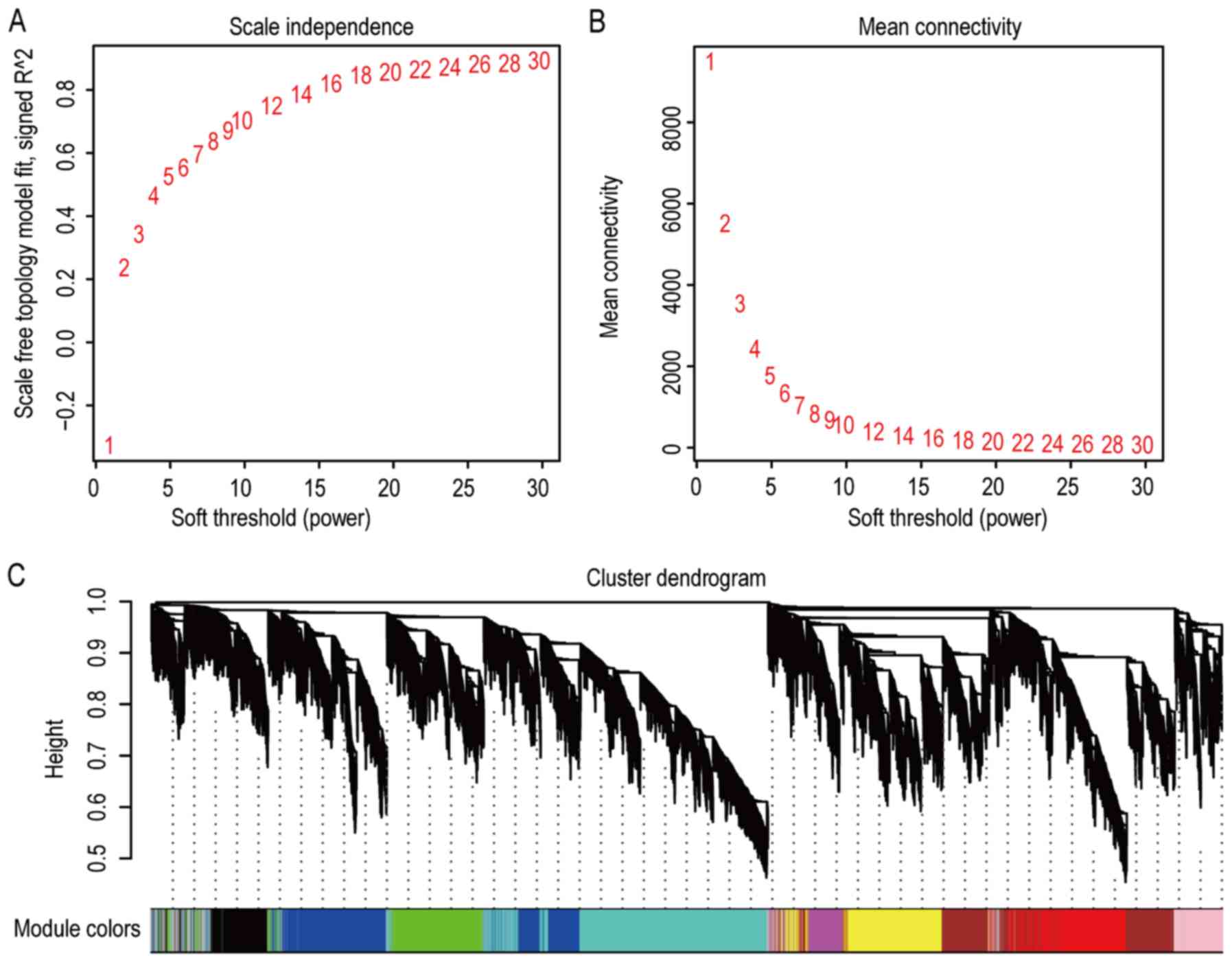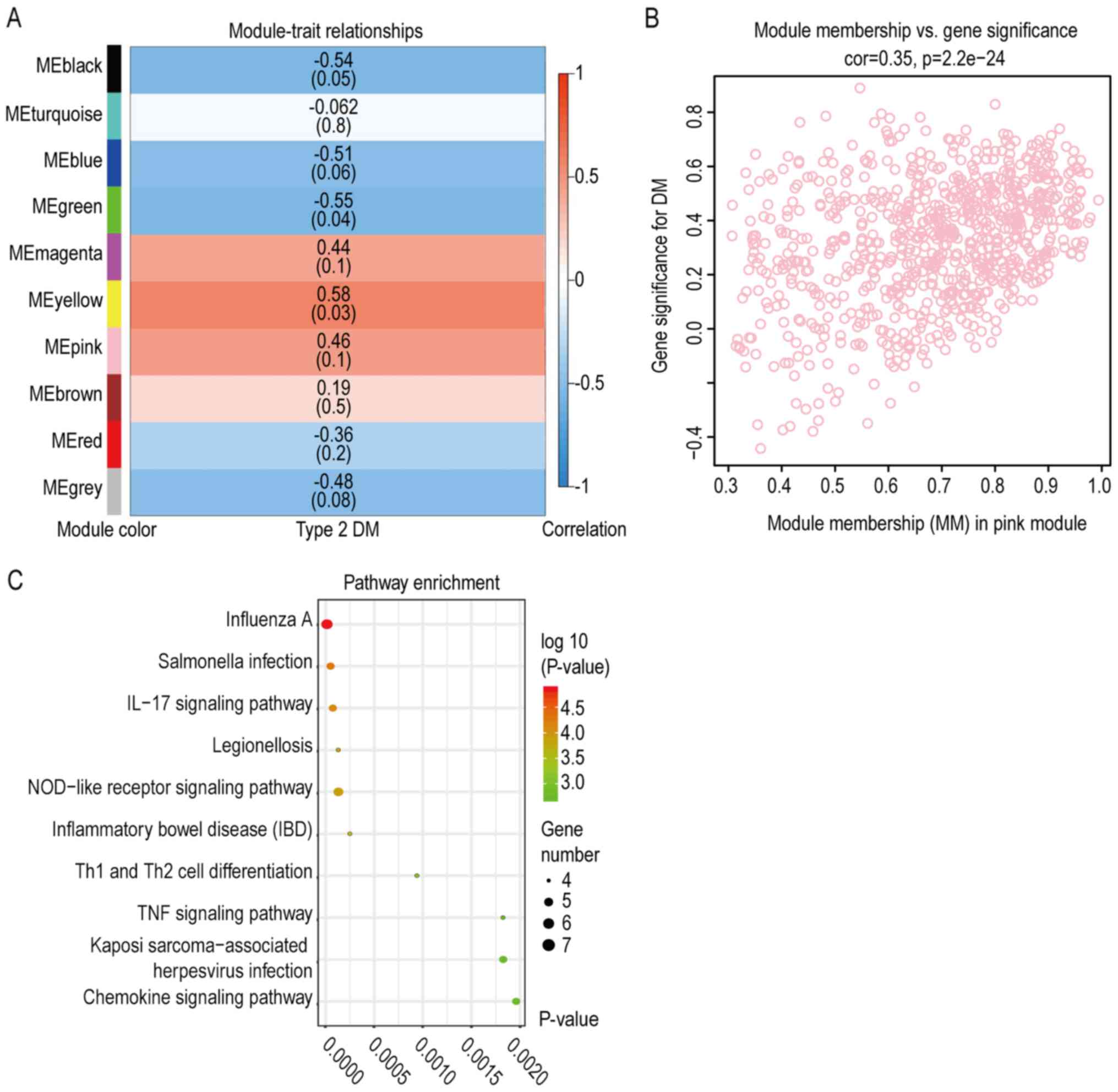Introduction
Diabetes mellitus (DM) is a worldwide health care
problem that places a heavy burden on patients and society.
Diabetes and other parameters of metabolic disorder are considered
risk factors for cardiovascular disease. Diabetic patients exhibit
a two- to four-fold increased risk of cardiovascular disease, while
endothelial cell dysfunction has a major role in the initiation and
progression of vascular complications (1). The endothelium is a semipermeable
monolayer of spindle-shaped endothelial layers that help maintain
vascular homeostasis under physiological conditions (2). In diabetes, endothelial function is
compromised, including reduced plasma nitric oxide, increased
generation of reactive oxygen species, increased leukocyte
infiltration and subsequent inflammation load (3,4).
Therefore, ameliorating endothelial dysfunction is a major focus
for the prevention and treatment of diabetic vascular
complications. Compared with type 1 DM, which is characterized by
the autoimmune destruction of β-cells, type 2 DM accounts for
90–95% of all cases of diabetes (5).
Type 2 DM is insulin-independent and usually characterized by a
partial reduction of insulin secretion and insulin resistance
(6).
Endothelial precursor cells (EPCs) are a group of
cells with the inherent capacity to differentiate into mature cells
(7). Asahara et al (8) reported on the isolation of these
CD34-positive mononuclear cells from human peripheral blood. EPCs
have been indicated to integrate into the capillary-vessel
endothelium of rodent hindlimbs induced by ligation of the artery
(9). Previous studies also revealed
the potency of EPCs in the treatment of endothelial dysfunction
induced by diabetes (10,11). However, compared with those in
healthy subjects, EPC counts were lower, and the function was also
disturbed in patients with either type of DM (12–14). The
development of strategies to improve the counts and activity of
EPCs in patients with DM is a major focus in the field of
autologous cell therapy. As EPCs from patients with diabetes
exhibit different behaviors compared with those from healthy
subjects, several different approaches have been investigated to
restore their dysregulation and dysfunction by targeting specific
sites (15–18).
In the present study, differentially expressed genes
(DEGs) in EPCs from patients with type 2 DM vs. healthy subjects
were identified. These DEGs were then subjected to gene ontology
(GO) and pathway enrichment analyses. A protein-protein interaction
(PPI) network was then constructed and visualized, and hub genes
were identified by molecular complex detection (MCODE). The top 9
hub genes were subsequently verified by reverse
transcription-quantitative (RT-q)PCR in an independent sample set
originating from our study center. To further explore the genes
that may be associated with the hub genes, a weighted gene
co-expression network analysis (WGCNA) was performed to determine a
relevant module that incorporates the hub genes, especially
interleukin 8 (IL8) and CXC chemokine ligand 1 (CXCL1).
Materials and methods
Obtainment and pre-processing of
microarray data
Gene expression profiles of EPCs from healthy and
type 2 diabetic subjects were obtained from the Gene Expression
Omnibus database (GEO; www.ncbi.nlm.nih.gov/geo/). The accession number was
GSE43950, and this dataset included a total of 14 samples: A total
of 9 type 2 diabetes late stage EPC samples and 5 healthy late EPC
stage samples. The definition of early and late stage EPCs is
discussed in a previous study (19).
Late EPC samples referred to the EPCs appeared aged 2–4 weeks and
exhibited a cobblestone-like morphology (8). The 9 type 2 diabetes late EPC samples
consisted of 5 samples obtained from the type 2 diabetes patients
with microvascular complications and 4 samples from the type 2
diabetes patients without clinical microvascular injuries. To
identify the DEGs in patients with type 2 diabetes vs. non-diabetic
controls, the 9 diabetes samples were analyzed together. The
platform used was the Rosetta/Merck Human RSTA Custom Affymetrix
2.0 microarray GPL10379. First, the expression matrix from the GEO
database was pre-processed using the robust multi-array analysis
method. The probe ID for each gene was then converted to a gene
symbol using annotation files obtained from the platform. DEGs were
identified by the limma algorithm (http://www.bioconductor.org/packages/2.9/bioc/html/limma.html)
in R software (20,21). A P-value of <0.05 and
|log2 fold change|≥1 were used as the cutoff criteria
for this analysis.
Enrichment analysis of DEGs
GO and Kyoto Encyclopedia of Genes and Genomes
(KEGG) pathway functional enrichment analyses were performed using
the database for annotation, visualization and integrated discovery
(DAVID; http://david.ncifcrf.gov/) (22). P<0.05 was considered to indicate
statistical significance and the GO results were ranked by P-value.
The significant terms for biological process (BP), cellular
component (CC) and molecular function (MF) were visualized in
Cytoscape (23). Furthermore, the
top 10 GO terms in the categories BP, CC and MF, and the top 10
KEGG pathways were presented in bubble plots generated with ggplot2
(https://cran.rproject.org/web/packages/ggplot2/index.html)
in R.
PPI network construction
A PPI network was generated to infer the
interactions among proteins. The PPI network was constructed using
the Search Tool for the Retrieval of Interacting Genes and proteins
(STRING) database (https://string-db.org/) (24). To explore the regulatory mechanisms,
interactions with the highest confidence of a combined score
>0.900 were imported into Cytoscape to construct the PPI
network.
Module selection
To obtain clusters of genes in the PPI network,
MCODE was used to identify the modules in the PPI network. The
cutoff criteria were ‘degree cutoff=2’, ‘node score cutoff=0.2’,
‘k-core=2’ and ‘maximum depth=100’.
Analysis of hub genes
To obtain a balance between the core genes and to
avoid missing any key gene, hub genes were extracted using
cytoHubba. A total of 12 topological analyses were provided by the
cytoHubba plugin (25). In
accordance with previous reports, a total of 3 most widely used
topological analysis methods, including maximal clique centrality
(MCC), maximum neighborhood component (MNC) and density of maximum
neighborhood component (DMNC), were used to identify potential hub
genes (25,26). The overlapping genes were selected as
the hub genes using Venn diagrams.
Construction of the co-expression
network and identification of significant modules
The WGCNA package in R was used to construct a
co-expression network (27). After
calculating the correlation of all pairwise genes by Pearson's
correlation matrices, the appropriate soft-threshold power β was
selected for the construction of modules using the
pickSoftThreshold function ranging from 1 to 30. The power of β=16
(scale-free R2=0.818) was selected to construct a
scale-free network. The topological overlap matrix (TOM) was
therefore constructed to measure the network connectivity of each
gene, defined as the sum of its adjacency with all other genes for
network generation (28). The
interaction analysis among different co-expression modules was
performed using the flashClust function, and the average linkage
hierarchical clustering was used with a minimum size of 500 for the
gene dendrogram (29). The
module-trait association was estimated using the correlation
between the module eigengene and the phenotype. Gene significance
(GS) was defined as the absolute value of the correlation between
expression profile and clinical trait. Module membership (MM) was
designated as the correlation of the expression profile and each
module eigengene (30). Genes with
higher intramodular connectivity (IC) were thought to have
biological significance compared with other genes in the module
(31). Therefore, the top 10% genes
ordered by IC were functionally annotated. Finally, KEGG functional
enrichment analysis of pathways in the pink module was performed
using the clusterProfiler package (32).
Isolation and cultivation of
circulating EPCs
The EPCs used in the present study were obtained
from patients diagnosed with type 2 DM or from non-diabetic
controls at Sir Run Run Shaw Hospital (Hangzhou, China). Type 2 DM
was diagnosed according to the American Diabetes Association
criteria (33). Inclusion/exclusion
criteria for the patients enrolled in the present study were as
follows: Age >50 years, willingness to provide written informed
consent, no acute myocardial infarction and no acute stroke. The
patients with type 2 DM were diagnosed >5 years previously.
Furthermore, major diabetic complications (diabetic retinopathy,
diabetic nephropathy, diabetic neuropathy, lower limb arteriopathy)
were recorded according to criteria described previously (34). A total of 8 patients were enrolled in
the present study between April 2017 and April 2018. EPCs were
isolated, cultured and characterized according to methods
previously reported (35). The study
procedure was approved by the Ethics Review Board of Sir Run Run
Shaw Hospital, School of Medicine. In brief, peripheral blood
mononuclear cells were isolated by density gradient centrifugation.
Cells were cultured in Endothelial Basal Medium-2 (Lonza Group,
Ltd.) supplemented with corresponding nutrient factors including
10% FBS (Gibco; Thermo Fisher Scientific, Inc.). Non-adherent cells
were removed after 4 days of primary culture. The culture was
maintained for another 7 days following addition of fresh medium.
The purity of the EPCs was verified using
tetramethylindocarbocyanine-labelled acetylated low-density
lipoprotein (DiLDL) uptake and lectin binding under a laser
scanning confocal microscope (data not shown) (Zeiss AG). The third
generation of EPCs was selected for the subsequent analysis.
Detailed information on these patients is provided in Supplemental
Table SI.
Validation of microarrays by
RT-qPCR
To verify the major conclusions drawn from the
microarray data, the expression levels of genes encoding for
identified hub genes in EPCs from patients were determined. The RNA
of EPCs was extracted using TRIzol reagent (CWBIO) and converted
into complementary (c)DNA using a PrimeScript RT reagent Kit
(Takara Biotechnology, Co. Ltd) according to the manufacturer's
protocol. Subsequently, qPCR was performed using UltraSYBR Mixture
(Low ROX; CWBIO) on the Lightcycler 480 II system (Roche Life
Science). For each well, the reaction mixture contained 2 µl cDNA,
0.4 µl forward primer (0.2 µM), 0.4 µl reverse primer (0.2 µM), 7.2
µl RNA-free water and 10 µl 2X UltraSYBR Mix. The reactions were
incubated at 95°C for 10 min, followed by 40 cycles of 95°C for 15
sec and 60°C for 1 min. The expression data were normalized to the
reference GAPDH. FCs of relative mRNA expression were calculated
using the change-in-threshold method (2−ΔΔCq) (37). The primer sets used for qPCR are
listed in Table I.
 | Table I.Primers used for quantitative
PCR. |
Table I.
Primers used for quantitative
PCR.
|
| Primer sequence
(5′→3′) |
|---|
|
|
|
|---|
| Gene | Forward | Reverse |
|---|
| IL8 |
TTTTGCCAAGGAGTGCTAAAGA |
AACCCTCTGCACCCAGTTTTC |
| FPR1 |
AAGGCCATGGGAGGACATTG |
CAGGGCCCAATGATCACCTT |
| CXCL1 |
CTGGCGGATCCAAGCAAATG |
GCCCCTTTGTTCTAAGCCAG |
| GNAI3 |
ATCGACCGCAACTTACGGG |
AGTCAATCTTTAGCCGTCCCA |
| FPR2 |
CTGAATGGATCAGAAGTGGTGG |
CCCAAATCACTAGTCCATTGCC |
| GNAI2 |
TACCGGGCGGTTGTCTACA |
GGGTCGGCAAAGTCGATCTG |
| ANXA1 |
GCGGTGAGCCCCTATCCTA |
TGATGGTTGCTTCATCCACAC |
| GNB1 |
GTGAGCTTGACCAGTTACGG |
TGTGATCTGAGAGAGAGTTGCAT |
| LPAR5 |
CGCCATCTTCCAGATGAAC |
TAGCGGTCCACGTTGATG |
| GAPDH |
CCTGCACCACCAACTGCTTA |
GGCCATCCACAGTCTTCTGAG |
Statistical analysis
All experiments were performed at least three times.
All results are expressed as the mean ± standard deviation.
Statistical analyses were performed using Student's t-test with
GraphPad Prism 7 software (GraphPad Software, Inc.). P<0.05 was
considered to indicate statistical significance.
Results
Identification of DEGs and clustering
analysis
A total of 970 DEGs were finally screened from the
expression profiles and are presented in a volcano plot in Fig. 1A.
Clustering analysis was then performed using the
pheatmap package in R and 970 DEGs were divided into two major
clusters (Fig. 1B). They included
822 upregulated and 148 downregulated genes (Fig. 1C). The top 10 upregulated and top 10
downregulated DEGs ranked by P-value are presented in Table II.
 | Table II.Top 10 up- and downregulated
differentially expressed genes. |
Table II.
Top 10 up- and downregulated
differentially expressed genes.
| A, Upregulated
genes |
|---|
|
|---|
| Gene | Average expression
value | Log2
FC | P-value |
|---|
| NLRP3 | 7.94243 | 3.05234 |
2.44×10−10 |
| NINJ1 | 8.64930 | 2.94253 |
2.39×10−9 |
| G0S2 | 9.91064 | 6.10854 |
1.88×10−8 |
| CKAP4 | 6.42605 | 2.65448 |
8.77×10−8 |
| MAFB | 9.35177 | 3.80994 |
1.78×10−7 |
| C20orf24 | 9.77482 | 1.48972 |
2.72×10−7 |
| C5AR1 | 7.62619 | 4.01330 |
3.48×10−7 |
| PTX3 | 6.21338 | 3.11387 |
3.64×10−7 |
| PFKFB3 | 8.33607 | 2.69583 |
4.12×10−7 |
| ID2 | 10.66494 | 1.77079 |
5.55×10−7 |
|
| B, Downregulated
genes |
|
| Gene | Average
expression value | Log2
FC | P-value |
|
| TRUB2 | 4.16713 | −1.14507 |
8.59×10−7 |
| PKIA | 5.22172 | −1.33779 |
3.09×10−5 |
| GPATCH4 | 7.44535 | −1.25382 |
3.87×10−5 |
| EIF5B | 8.92228 | −1.07249 |
4.75×10−5 |
| CNNM3 | 6.16580 | −1.40637 |
1.23×10−4 |
| CD72 | 3.27212 | −1.55625 |
1.30×10−4 |
| ZDHHC14 | 5.93256 | −1.11224 |
1.68×10−4 |
| ENO2 | 4.21881 | −1.58752 |
1.72×10−4 |
| PPM1K | 3.60385 | −1.38364 |
2.05×10−4 |
| DAZAP1 | 9.80455 | −1.03973 |
2.29×10−4 |
Enrichment analysis of DEGs
To explore the GO terms and pathways in which the
DEGs were mainly involved, the 970 DEGs were uploaded onto the
DAVID website. The most enriched GO terms in the category BP
included ‘inflammatory response’, ‘cellular response to
lipopolysaccharide’, ‘innate immune response’, ‘immune response’
and ‘lipopolysaccharide-mediated signaling pathway’ (Fig. 2A). In the category CC, the GO terms
with the highest enrichment were mainly associated with
‘extracellular exosomes’, ‘plasma membranes’, ‘lysosomes and cell
surface’ (Fig. 2B). As for the
category MF, the GO terms with the highest accumulation of DEGs
were ‘protein binding, receptor activity’, ‘carbohydrate binding’
and ‘lipopolysaccharide receptor activity’ (Fig. 2C).
To identify pathways significantly enriched by the
DEGs, KEGG pathway analysis was performed. The enrichment analysis
of the KEGG pathways demonstrated that DEGs were mainly enriched in
the ‘NF-κB signaling pathway’, ‘tumor necrosis factor (TNF)
signaling pathway’ and ‘inflammatory bowel disease’ (Fig. 2D).
PPI network construction and module
analysis
A total of 394 nodes and 1,486 interactional pairs
were included in the PPI network (Fig.
3). Among them, proteins with degrees of ≥20 were visualized in
detail. A total of 5 proteins had degrees of interaction of ≥30
[IL8, 43; ubiquitin conjugating enzyme E2 D1 (UNE2D1), 35; G
protein subunit beta 1 (GNB1), 33; E1A binding protein p300
(EP300), 32; Cbl proto-oncogene (CBL), 30]. In addition, a
subnetwork clustering analysis was performed using the MCODE
plugin. The top 3 subnet modules were identified (Fig. 4A-C). Module a (score=20.634) included
42 nodes and 423 interactional pairs (Fig. 4A). Module b (score=12.000) included
12 nodes and 66 interactional pairs (Fig. 4B). Module c (score=7.641) included 40
nodes and 149 interactional pairs (Fig.
4C).
Hub gene selection
The hub genes were determined by overlapping the top
20 genes obtained using three topological analysis methods, MCC,
MNC and DMNC (Fig. 5A). A total of 9
genes were selected, including 8 upregulated genes and 1
downregulated gene (Fig. 5B;
Table III).
 | Table III.Information on the 9 hub genes. |
Table III.
Information on the 9 hub genes.
| Gene | Log2
FC | P-value | Degree | Expression
alteration |
|---|
| IL8 | 3.89158 |
9.02×10−6 | 43 | Upregulated |
| FPR1 | 3.04300 |
4.82×10−5 | 22 | Upregulated |
| CXCL1 | 2.49797 |
3.30×10−4 | 22 | Upregulated |
| GNAI3 | 2.09317 |
1.38×10−3 | 24 | Upregulated |
| FPR2 | 2.83408 |
2.84×10−3 | 26 | Upregulated |
| GNAI2 | 1.01805 |
3.26×10−3 | 22 | Upregulated |
| ANXA1 | 2.18436 |
4.56×10−3 | 26 | Upregulated |
| GNB1 | 1.12879 |
1.48×10−2 | 33 | Upregulated |
| LPAR5 | −1.20699 |
2.81×10−2 | 25 | Downregulated |
Validation of hub genes by
RT-qPCR
RT-qPCR was used to validate hub genes obtained in
the above analysis. EPCs were isolated from 4 non-diabetic controls
and 4 diabetic patients. The detailed information of these patients
were presented in Table S1. The
patients that met the criteria were included from April 2017 to
April 2018. The mRNA expression levels of IL8, formyl peptide
receptor 1 (FPR1), CXCL1, GNAI3, FPR2, GNAI2, annexin A1 (ANXA1),
GNB1 and lysophosphatidic acid receptor 5 (LPAR5) were determined.
Overall, the results were similar to those of the microarray
analysis, while the RT-qPCR results indicated greater fold changes
than those calculated from the gene array data (Fig. 6). Of all 9 genes, IL8 and CXCL1
exhibited the most significant changes.
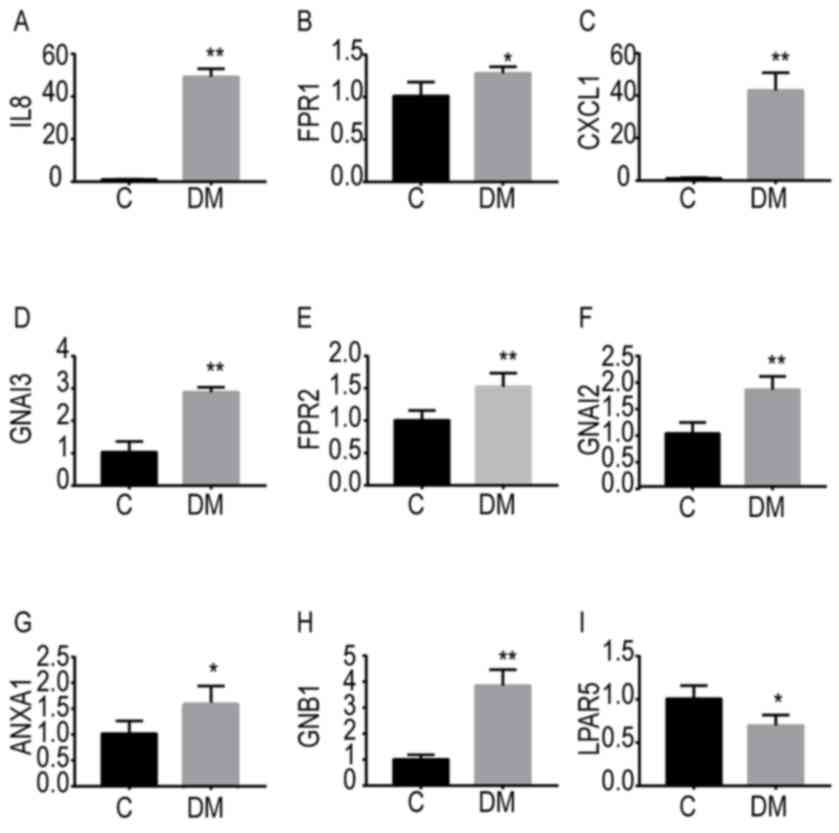 | Figure 6.Validation of microarray data by
quantitative PCR. The expression of the top 9 hub genes identified
from the microarray in detected in endothelial progenitor cells
from patients with DM and healthy controls is provided in bar
graphs. (A) IL8, (B) FPR1, (C) CXCL1, (D) GNAI3, (E) FPR2, (F)
GNAI2, (G) ANXA1, (H) GNB1, (I) LPAR5. Values are expressed as the
mean ± standard deviation (n=4 in each experiment). *P<0.05,
**P<0.01 vs. control group. DM, diabetes mellitus; C, control;
IL8, interleukin 8; FPR1, formyl peptide receptor 1; CXCL1, C-X-C
motif chemokine ligand 1; GNAI3, G protein subunit alpha I3; FPR2,
formyl peptide receptor 2; GNAI2, G protein subunit alpha 2; ANXA1,
annexin A1; GNB1, G protein subunit beta 1; LPAR5, lysophosphatidic
acid receptor 5. |
WGCNA and key module
identification
To further explore the roles of chemokines in EPCs
under diabetic conditions, WGCNA was used to identify the relevant
modules incorporating IL8 and CXCL1. Prior to construction of the
co-expression network, the soft-threshold power of 16 was selected
to define the adjacency matrix based on the criterion of
approximate scale-free topology (Fig. 7A
and B). After determining the soft-threshold, the TOM was
built. A total of 9 distinct gene co-expression modules for EPCs
were constructed and are presented in different colors (Fig. 7C). IL8 and CXCL1 are included in the
pink module (Fig. 8A). The values
between module membership (MM) and gene significance (GS) in the
pink module were presented in Fig.
8B. Genes with high IC were indicated to be tightly associated
with other genes. The top 10% genes in the pink module ordered by
IC were mainly enriched in the pathway of IL17 and the chemokine
signaling pathway using KEGG pathway analysis (Fig. 8C).
Discussion
EPCs are a group of multipotent precursor cells that
have the capacity to differentiate into blood vessels and blood
cells (38). However, in previous
studies, the number and function of EPCs were indicated to be
decreased in patients with type 2 DM (12,39).
Thus, identification of DEGs may be beneficial for the elucidation
of the pathophysiology of EPCs in patients with diabetes. By
analyzing the expression profiles in the dataset GSE43950
downloaded from the GEO database, 970 DEGs were identified,
including 822 upregulated and 148 downregulated genes. Subsequent
analyses included GO enrichment analysis of DEGs, KEGG pathway
analysis, module selection by MCODE and identification of hub genes
by cytoHubba. Thereafter, hub genes selected from the PPI network
were validated by RT-qPCR and associated modules containing hub
genes with the highest FC were investigated. To the best of our
knowledge, the present study was the first aiming to determine
potential genes associated with EPCs in patients with type 2 DM.
The present study provides novel insight into the molecular
mechanisms of dysfunctional EPCs in patients with type 2 DM.
Through the use of DAVID, GO enrichment analysis of
the 970 DEGs was performed and the most enriched GO terms in the
category BP were associated with ‘inflammatory response, response
to lipopolysaccharide’ and ‘innate immune response’ in patients
with type 2 DM. In the category CC, enriched GO terms were mainly
associated with ‘extracellular exosomes’, ‘plasma membranes’ and
‘lysosomes’. In the category MF, GO terms enriched for DEGs in DM
groups included ‘protein binding’ and ‘receptor activity’. KEGG
pathway analysis indicated that the DEGs of the type 2 DM group
were mainly enriched in the ‘TNF signaling pathway’ and ‘NF-κB
signaling pathway’. The GO terms ‘inflammatory response’, ‘response
to lipopolysaccharide’ and ‘innate immune response’ fit well with
concept of an inflammatory phenotype in the EPCs of type 2 DM as
described previously (15). Indeed,
it has been indicated that anti-diabetic drugs that possess the
capacity to increase EPC numbers and inhibit premature apoptosis
may protect EPCs from injury by DM partly through alleviation of
inflammation (40). In the category
CC, the GO term ‘extracellular exosome’ was indicated to be of high
relevance. Exosomes have been reported to have an important role in
the performance of EPCs under certain physiological and
pathological conditions (41–43). It
is reasonable to speculate that the decreased number and inhibited
function of EPCs may partially be attributed to the altered exosome
content of EPCs in patients with type 2 DM. These exosomes may
perform multiple biological functions, including angiogenesis and
wound healing (43,44). In the category MF, DEGs were mainly
enriched in ‘protein binding’, ‘receptor activity’ and
‘lipopolysaccharide receptor activity’. As for the KEGG pathways,
the ‘NF-κB signaling pathway’ and ‘TNF signaling pathway’ were
enriched in EPCs of patients with type 2 DM. Above all, these
results indicated that inflammation may have a major role in the
initiation and progression of dysfunction of EPCs in patients with
DM, in accordance with previous studies (15,43).
To illustrate the interaction of the DEGs, a PPI
network was constructed using the STRING database. The top 3 subnet
modules based on the PPI network were then selected by MCODE. GO
enrichment analysis of these modules (including subnet modules a,
b, and c) revealed that these subnet modules were mainly enriched
in the terms inflammation, endocytosis and Golgi vesicle-mediated
transport processes. The results of the enrichment analysis in the
subnet modules further demonstrated that inflammation may be
crucial for the dysfunction of EPCs in patients with type 2 DM.
By overlapping the top 20 genes obtained from the
MCC, MNC and DMNC methods, 9 genes were selected (IL8, FPR1, CXCL1,
GNAI3, FPR2, GNAI2, ANXA1, GNB1 and LPAR5). Among these genes, IL8
exhibited the most significant difference between the diabetic and
control samples. IL8, as a member of the chemokines, has been
reported to activate the motile apparatus of neutrophils, inducing
the surface adhesion of inflammatory cells (45). Monocytes and macrophages are usually
considered the principal cellular source of IL8. However, a wide
variety of nucleated cells, including EPCs, are potential sources
of IL8 (46). Previous studies have
indicated that in patients with type 2 DM, IL8 is elevated in the
plasma compared with that in healthy subjects (47). IL8 is considered a canonical
angiogenic factor and has a crucial role in the protection of EPCs
for attenuating injury and prompting recovery of damaged tissues
(48–50). Consistent with a previous study, the
current study indicated that IL8 was significantly higher in the
microarrays of EPCs isolated from patients with diabetes (51). Furthermore, the results of detecting
mRNA expression in EPCs under type 2 DM by RT-qPCR were
similar. All these results indicated that elevated IL8 may be
involved in the dysfunction of EPCs during the long-term injury
associated with type 2 DM.
Besides IL8, CXCL1 was also significantly elevated
with a similar degree to that of IL8. CXCL1, best known for its
chemotactic activity toward neutrophils and monocytes/macrophages,
is also a potent angiogenic factor (52). Herlea-Pana et al (53) reported that CXCL1 and its cognate
receptor, CXC motif chemokine-receptor-2 (CXCR2), were increased in
Reversa mice, an animal model apt to develop plaques when fed an
atherosclerosis-inducing western diet. Of note, elevated
CXCL1-CXCR2 was indicated to have a protective effect to prevent
the progression of plaque formation, while CXCR2 was able to
recruit EPCs to the plaques to repair the injured endothelium.
Likewise, the chemokine system was indicated to be associated with
homing and engraftment of EPCs (54). Above all, these results indicated
that the chemokine system has an important role in the regulation
of EPCs under diabetic conditions.
To further explore the genes that may be associated
with IL8 and CXCL1 in the microarray data, WGCNA was performed to
determine the relevant module that incorporates IL8 and CXCL1. A
total of 9 modules were recognized by dynamic tree cut, of which
the pink module contained IL8 and CXCL1. Most genes in this module
were enriched in the TNF signaling pathway, the chemokine signaling
pathway and the NOD-like receptor signaling pathway. These pathways
fit well with the concept of an inflammatory and immune system
disorder in type 2 DM (55,56).
The microarray data analyzed in the present study
were deposited in the GEO as the dataset GSE43950. By analyzing
these microarray data, the present study aimed to identify
candidate genes that may be helpful for understanding the roles of
EPC dysfunction under type 2 DM conditions and the associated
mechanisms. Furthermore, to minimize the bias in the original
expression profiles and to better understand the functional terms
and pathways of the DEGs in the EPCs influenced by type 2 DM, the
array data were analyzed in three steps. First, DEGs between
healthy subjects and diabetes patients were determined from the
microarrays using the classical bioinformatics analysis tool,
limma. Subsequent enrichment analysis was performed by DAVID. Hub
genes and associated modules based on PPI network were selected
using cytohubba in Cytoscape. Thereafter, the predicted hub genes
were validated by RT-qPCR of EPCs isolated from patients at Sir Run
Run Shaw Hospital (Hangzhou, China). IL8 and CXCL1 were found to
exhibit the greatest variation in the EPCs of patients. To identify
the genes that were co-expressed with IL8 and CXCL1, WGCNA, which
is an algorithm recently wide used in microarray data analyses to
identify the modules with similar expression patterns, was applied
in the current study (57). After
selecting the appropriate soft-threshold power β, the pink module
was indicated to incorporate IL8 and CXCL1.
The present results indicated that inflammation may
be an important mechanism underlying the difference in function and
number of EPCs isolated from healthy individuals and diabetic
patients. EPCs have long been regarded as a potential therapy to
accelerate re-endothelialization of impaired vessels. Elevated IL8
expression is also thought to be involved in the repair progress
(18). Compared to the successful
preclinical results, the results of clinical trials on the efficacy
parameters are conflicting (58,59).
Certain studies indicated no beneficial effect of autologous EPC
transplantation in diabetic patients with critical limb ischemia
(58). The controversy may be
attributed to the heterogeneity of survival and different sources
of EPCs in these trials (7,58). The present results revealed that
inflammatory responses and associated genes may be partially
involved in the abnormal function and number of EPCs in patients
with diabetes.
Taken together, the present study identified DEGs in
the EPCs of patients with type 2 DM vs. healthy subjects, which may
be involved in the changes in the number and function of EPCs in
patients with type 2 DM. Hub genes (IL8, FPR1, CXCL1, GNAI3, FPR2,
GNAI2, ANXA1, GNB1 and LPAR5) extracted from the PPI network may be
helpful as potential diagnostic and prognostic biomarkers of
disordered EPCs. In addition, inflammatory responses are critical
for the reduced number and hypofunction of EPCs isolated from
diabetic patients.
The present study has several limitations that
should be pointed out. First, it was not possible to conclude
whether changes in gene expression were the cause or consequence of
the complex physiological environment in patients with type 2 DM.
Furthermore, the sample size of EPCs was relatively small (n=4 for
each group). Third, due to the lack of a sorting machine, the EPCs
in the present study were isolated and cultured in culture dishes.
EPCs isolated from the patients in Sir Run Run Shaw Hospital were
cultured in vitro while CD34+ cells were directly
sorted in GSE43950. Therefore, the fold changes of identified hub
genes may not fit well with the predicted outcomes of microarrays
in GSE43950. Finally, as the clinical traits in the dataset
GSE43950 were limited, the exact clinical characteristics of these
patients were not known. In the current, the probes were annotated
using the platform annotation file, which was last updated in July
09, 2014 (https://www.ncbi.nlm.nih.gov/geo/query/acc.cgi?acc=GPL10379).
Therefore, some proteins discovered in the past few years may not
be identified in the present study.
Supplementary Material
Supporting Data
Acknowledgements
Not applicable.
Funding
This study was supported by a grant from the Natural
Science Funds of Zhejiang Province, China (grant no. LY16H020005,
LY16H020007, LQ19H020011 and LY19H020007), the Natural Key Research
and Development Project of Zhejiang Province, China (grant no.
2018C03015) and the National Natural Science Foundation of China
(grant nos. 81800706 and 81570246). The funders had no role in
study design, data collection and analysis, manuscript preparation
or decision to publish.
Availability of data and materials
The datasets used and/or analyzed in the present
study are available from the corresponding author on reasonable
request.
Authors' contributions
GF and YZ were involved in the conception and design
of the study. ZS and QC acquired the data and prepared the
manuscript. HY, ZM, XB, XL, MW, CJ and DWL analyzed and interpreted
the data and performed the statistical analysis. All authors read
and approved the final manuscript.
Ethics approval and consent to
participate
The study was approved by the Ethics Committee of
Sir Run Run Shaw Hospital, School of Medicine, Zhejiang University
(Hangzhou, China). All of the patients provided written informed
consent to participate in the study.
Patient consent for publication
Not applicable.
Competing interests
The authors declare that they have no competing
interests.
References
|
1
|
Shi Y and Vanhoutte PM: Macro- and
microvascular endothelial dysfunction in diabetes. J Diabetes.
9:434–449. 2017. View Article : Google Scholar : PubMed/NCBI
|
|
2
|
Yang C, Kelaini S, Caines R and Margariti
A: RBPs play important roles in vascular endothelial dysfunction
under diabetic conditions. Front Physiol. 9:13102018. View Article : Google Scholar : PubMed/NCBI
|
|
3
|
Zhang HN, Xu QQ, Thakur A, Alfred MO,
Chakraborty M, Ghosh A and Yu XB: Endothelial dysfunction in
diabetes and hypertension: Role of microRNAs and long non-coding
RNAs. Life Sci. 213:258–268. 2018. View Article : Google Scholar : PubMed/NCBI
|
|
4
|
Giacco F and Brownlee M: Oxidative stress
and diabetic complications. Circ Res. 107:1058–1070. 2010.
View Article : Google Scholar : PubMed/NCBI
|
|
5
|
Zimmet P, Alberti KG and Shaw J: Global
and societal implications of the diabetes epidemic. Nature.
414:782–787. 2001. View
Article : Google Scholar : PubMed/NCBI
|
|
6
|
Vijan S: In the clinic. Type 2 diabetes.
Ann Intern Med. 152:ITC31-15; quiz ITC316. 2010. View Article : Google Scholar
|
|
7
|
Pyšná A, Bém R, Němcová A, Fejfarová V,
Jirkovská A, Hazdrová J, Jude EB and Dubský M: Endothelial
progenitor cells biology in diabetes mellitus and peripheral
arterial disease and their therapeutic potential. Stem Cell Rev.
15:157–165. 2019. View Article : Google Scholar
|
|
8
|
Asahara T, Murohara T, Sullivan A, Silver
M, van der Zee R, Li T, Witzenbichler B, Schatteman G and Isner JM:
Isolation of putative progenitor endothelial cells for
angiogenesis. Science. 275:964–967. 1997. View Article : Google Scholar : PubMed/NCBI
|
|
9
|
Asahara T and Kawamoto A: Endothelial
progenitor cells for postnatal vasculogenesis. Am J Physiol Cell
Physiol. 287:C572–579. 2004. View Article : Google Scholar : PubMed/NCBI
|
|
10
|
Dubsky M, Jirkovska A, Bem R, Nemcova A,
Fejfarova V and Jude EB: Cell therapy of critical limb ischemia in
diabetic patients-State of art. Diabetes Res Clin Pract.
126:263–271. 2017. View Article : Google Scholar : PubMed/NCBI
|
|
11
|
Amann B, Luedemann C, Ratei R and
Schmidt-Lucke JA: Autologous bone marrow cell transplantation
increases leg perfusion and reduces amputations in patients with
advanced critical limb ischemia due to peripheral artery disease.
Cell Transplant. 18:371–380. 2009. View Article : Google Scholar : PubMed/NCBI
|
|
12
|
Liao YF, Chen LL, Zeng TS, Li YM, Fan Yu,
Hu LJ and Ling Yue: Number of circulating endothelial progenitor
cells as a marker of vascular endothelial function for type 2
diabetes. Vasc Med. 15:279–285. 2010. View Article : Google Scholar : PubMed/NCBI
|
|
13
|
Sibal L, Aldibbiat A, Agarwal SC, Mitchell
G, Oates C, Razvi S, Weaver JU, Shaw JA and Home PD: Circulating
endothelial progenitor cells, endothelial function, carotid
intima-media thickness and circulating markers of endothelial
dysfunction in people with type 1 diabetes without macrovascular
disease or microalbuminuria. Diabetologia. 52:1464–1473. 2009.
View Article : Google Scholar : PubMed/NCBI
|
|
14
|
Tepper OM, Galiano RD, Capla JM, Kalka C,
Gagne PJ, Jacobowitz GR, Levine JP and Gurtner GC: Human
endothelial progenitor cells from type II diabetics exhibit
impaired proliferation, adhesion, and incorporation into vascular
structures. Circulation. 106:2781–2786. 2002. View Article : Google Scholar : PubMed/NCBI
|
|
15
|
Yiu KH and Tse HF: Specific role of
impaired glucose metabolism and diabetes mellitus in endothelial
progenitor cell characteristics and function. Arterioscler Thromb
Vasc Biol. 34:1136–1143. 2014. View Article : Google Scholar : PubMed/NCBI
|
|
16
|
Chen LL, Liao YF, Zeng TS, Yu F, Li HQ and
Feng Y: Effects of metformin plus gliclazide compared with
metformin alone on circulating endothelial progenitor cell in type
2 diabetic patients. Endocrine. 38:266–275. 2010. View Article : Google Scholar : PubMed/NCBI
|
|
17
|
Chang TT, Lin LY and Chen JW: Inhibition
of macrophage inflammatory protein-1β improves endothelial
progenitor cell function and ischemia-induced angiogenesis in
diabetes. Angiogenesis. 22:53–65. 2019. View Article : Google Scholar : PubMed/NCBI
|
|
18
|
Ambasta RK, Kohli H and Kumar P: Multiple
therapeutic effect of endothelial progenitor cell regulated by
drugs in diabetes and diabetes related disorder. J Transl Med.
15:1852017. View Article : Google Scholar : PubMed/NCBI
|
|
19
|
Cheng CC, Chang SJ, Chueh YN, Huang TS,
Huang PH, Cheng SM, Tsai TN, Chen JW and Wang HW: Distinct
angiogenesis roles and surface markers of early and late
endothelial progenitor cells revealed by functional group analyses.
BMC Genomics. 14:1822013. View Article : Google Scholar : PubMed/NCBI
|
|
20
|
Gentleman RC, Carey VJ, Bates DM, Bolstad
B, Dettling M, Dudoit S, Ellis B, Gautier L, Ge Y, Gentry J, et al:
Bioconductor: Open software development for computational biology
and bioinformatics. Genome Biol. 5:R802004. View Article : Google Scholar : PubMed/NCBI
|
|
21
|
Reiner A, Yekutieli D and Benjamini Y:
Identifying differentially expressed genes using false discovery
rate controlling procedures. Bioinformatics. 19:368–375. 2003.
View Article : Google Scholar : PubMed/NCBI
|
|
22
|
Dennis G Jr, Sherman BT, Hosack DA, Yang
J, Gao W, Lane HC and Lempicki RA: DAVID: Database for annotation,
visualization, and integrated discovery. Genome Biol. 4:P32003.
View Article : Google Scholar : PubMed/NCBI
|
|
23
|
Shannon P, Markiel A, Ozier O, Baliga NS,
Wang JT, Ramage D, Amin N, Schwikowski B and Ideker T: Cytoscape: A
software environment for integrated models of biomolecular
interaction networks. Genome Res. 13:2498–2504. 2003. View Article : Google Scholar : PubMed/NCBI
|
|
24
|
Szklarczyk D, Morris JH, Cook H, Kuhn M,
Wyder S, Simonovic M, Santos A, Doncheva NT, Roth A, Bork P, et al:
The STRING database in 2017: Quality-controlled protein-protein
association networks, made broadly accessible. Nucleic Acids Res.
45:D362–D368. 2017. View Article : Google Scholar : PubMed/NCBI
|
|
25
|
Chin CH, Chen SH, Wu HH, Ho CW, Ko MT and
Lin CY: CytoHubba: Identifying hub objects and sub-networks from
complex interactome. BMC Syst Biol. 4 (Suppl 8):S112014. View Article : Google Scholar
|
|
26
|
Liu J, Yu Z, Sun M, Liu Q, Wei M and Gao
H: Identification of cancer/testis antigen 2 gene as a potential
hepatocellular carcinoma therapeutic target by hub gene screening
with topological analysis. Oncol Lett. 18:4778–4788.
2019.PubMed/NCBI
|
|
27
|
Langfelder P and Horvath S: WGCNA: An R
package for weighted correlation network analysis. BMC
Bioinformatics. 9:5592008. View Article : Google Scholar : PubMed/NCBI
|
|
28
|
Yip AM and Horvath S: Gene network
interconnectedness and the generalized topological overlap measure.
BMC Bioinformatics. 8:222007. View Article : Google Scholar : PubMed/NCBI
|
|
29
|
Ravasz E, Somera AL, Mongru DA, Oltvai ZN
and Barabasi AL: Hierarchical organization of modularity in
metabolic networks. Science. 297:1551–1555. 2002. View Article : Google Scholar : PubMed/NCBI
|
|
30
|
Shi K, Bing ZT, Cao GQ, Guo L, Cao YN,
Jiang HO and Zhang MX: Identify the signature genes for diagnose of
uveal melanoma by weight gene co-expression network analysis. Int J
Ophthalmol. 8:269–274. 2015.PubMed/NCBI
|
|
31
|
Wang T, Zheng X, Li R, Liu X, Wu J, Zhong
X, Zhang W, Liu Y, He X, Liu W, et al: Integrated bioinformatic
analysis reveals YWHAB as a novel diagnostic biomarker for
idiopathic pulmonary arterial hypertension. J Cell Physiol.
234:6449–6462. 2019. View Article : Google Scholar : PubMed/NCBI
|
|
32
|
Huang da W, Sherman BT and Lempicki RA:
Bioinformatics enrichment tools: Paths toward the comprehensive
functional analysis of large gene lists. Nucleic Acids Res.
37:1–13. 2009. View Article : Google Scholar : PubMed/NCBI
|
|
33
|
American Diabetes A: Diagnosis and
classification of diabetes mellitus. Diabetes Care. 37 (Suppl
1):S81–S90. 2014. View Article : Google Scholar : PubMed/NCBI
|
|
34
|
Del Coco L, Vergara D, De Matteis S, Mensà
E, Sabbatinelli J, Prattichizzo F, Bonfigli AR, Storci G,
Bravaccini S, Pirini F, et al: NMR-based metabolomic approach
tracks potential serum biomarkers of disease progression in
patients with type 2 diabetes mellitus. J Clin Med. 8:E7202019.
View Article : Google Scholar : PubMed/NCBI
|
|
35
|
Zhao Y, Qiu F, Xu S, Yu L and Fu G:
Thymosin β4 activates integrin-linked kinase and decreases
endothelial progenitor cells apoptosis under serum deprivation. J
Cell Physiol. 226:2798–2806. 2011. View Article : Google Scholar : PubMed/NCBI
|
|
36
|
Mason MJ, Fan G, Plath K, Zhou Q and
Horvath S: Signed weighted gene co-expression network analysis of
transcriptional regulation in murine embryonic stem cells. BMC
Genomics. 10:3272009. View Article : Google Scholar : PubMed/NCBI
|
|
37
|
Shen Z, Chen Q, Jin T, Wang M, Ying H, Lu
J, Wang M, Zhang W, Qiu F, Jin C, et al: Theaflavin 3,3′-digallate
reverses the downregulation of connexin 43 and autophagy induced by
high glucose via AMPK activation in cardiomyocytes. J Cell Physiol.
234:17999–18016. 2019. View Article : Google Scholar : PubMed/NCBI
|
|
38
|
Raval Z and Losordo DW: Cell therapy of
peripheral arterial disease: From experimental findings to clinical
trials. Circ Res. 112:1288–1302. 2013. View Article : Google Scholar : PubMed/NCBI
|
|
39
|
Egan CG, Lavery R, Caporali F, Fondelli C,
Laghi-Pasini F, Dotta F and Sorrentino V: Generalised reduction of
putative endothelial progenitors and CXCR4-positive peripheral
blood cells in type 2 diabetes. Diabetologia. 51:1296–1305. 2008.
View Article : Google Scholar : PubMed/NCBI
|
|
40
|
Lois N, McCarter RV, O'Neill C, Medina RJ
and Stitt AW: Endothelial progenitor cells in diabetic retinopathy.
Front Endocrinol (Lausanne). 5:442014. View Article : Google Scholar : PubMed/NCBI
|
|
41
|
Ma C, Wang J, Liu H, Chen Y, Ma X, Chen S,
Chen Y, Bihl JI and Yang YI: Moderate exercise enhances endothelial
progenitor cell exosomes release and function. Med Sci Sports
Exerc. 50:2024–2032. 2018. View Article : Google Scholar : PubMed/NCBI
|
|
42
|
Sun J, Zhang Z, Ma T, Yang Z, Zhang J, Liu
X, Lu D, Shen Z, Yang J and Meng Q: Endothelial progenitor
cell-derived exosomes, loaded with miR-126, promoted deep vein
thrombosis resolution and recanalization. Stem Cell Res Ther.
9:2232018. View Article : Google Scholar : PubMed/NCBI
|
|
43
|
Zhang J, Chen C, Hu B, Niu X, Liu X, Zhang
G, Zhang C, Li Q and Wang Y: Exosomes derived from human
endothelial progenitor cells accelerate cutaneous wound healing by
promoting angiogenesis through Erk1/2 signaling. Int J Biol Sci.
12:1472–1487. 2016. View Article : Google Scholar : PubMed/NCBI
|
|
44
|
Ke X, Yang D, Liang J, Wang X, Wu S, Wang
X and Hu C: Human endothelial progenitor cell-derived exosomes
increase proliferation and angiogenesis in cardiac fibroblasts by
promoting the mesenchymal-endothelial transition and reducing high
mobility group Box 1 protein B1 expression. DNA Cell Biol.
36:1018–1028. 2017. View Article : Google Scholar : PubMed/NCBI
|
|
45
|
Sikora J, Smycz-Kubanska M,
Mielczarek-Palacz A and Kondera-Anasz Z: Abnormal peritoneal
regulation of chemokine activation-the role of IL-8 in pathogenesis
of endometriosis. Am J Reprod Immunol. 77:2017. View Article : Google Scholar : PubMed/NCBI
|
|
46
|
Remick DG: Interleukin-8. Crit Care Med.
33 (12 Suppl):S466–S467. 2005. View Article : Google Scholar : PubMed/NCBI
|
|
47
|
Cai W, Qiu C, Zhang H, Chen X, Zhang X,
Meng Q and Wei J: Detection of circulating natural antibodies to
inflammatory cytokines in type-2 diabetes and clinical
significance. J Inflamm (Lond). 14:242017. View Article : Google Scholar : PubMed/NCBI
|
|
48
|
Barcelos LS, Duplaa C, Kränkel N, Graiani
G, Invernici G, Katare R, Siragusa M, Meloni M, Campesi I, Monica
M, et al: Human CD133+ progenitor cells promote the healing of
diabetic ischemic ulcers by paracrine stimulation of angiogenesis
and activation of wnt signaling. Circ Res. 104:1095–1102. 2009.
View Article : Google Scholar : PubMed/NCBI
|
|
49
|
Chen C, Lin X, Wang J, Tang G, Mu Z, Chen
X, Xu J, Wang Y, Zhang Z and Yang GY: Effect of HMGB1 on the
paracrine action of EPC promotes post-ischemic neovascularization
in mice. Stem Cells. 32:2679–2689. 2014. View Article : Google Scholar : PubMed/NCBI
|
|
50
|
Liang X, Ding Y, Zhang Y, Tse HF and Lian
Q: Paracrine mechanisms of mesenchymal stem cell-based therapy:
Current status and perspectives. Cell Transplant. 23:1045–1059.
2014. View Article : Google Scholar : PubMed/NCBI
|
|
51
|
Montane J, Cadavez L and Novials A: Stress
and the inflammatory process: A major cause of pancreatic cell
death in type 2 diabetes. Diabetes Metab Syndr Obes. 7:25–34.
2014.PubMed/NCBI
|
|
52
|
Belo AV, Leles F, Barcelos LS, Ferreira
MA, Bakhle YS, Teixeira MM and Andrade SP: Murine chemokine
CXCL2/KC is a surrogate marker for angiogenic activity in the
inflammatory granulation tissue. Microcirculation. 12:597–606.
2005. View Article : Google Scholar : PubMed/NCBI
|
|
53
|
Herlea-Pana O, Yao L, Heuser-Baker J, Wang
Q, Wang Q, Georgescu C, Zou MH and Barlic-Dicen J: Chemokine
receptors CXCR2 and CX3CR1 differentially regulate functional
responses of bone-marrow endothelial progenitors during
atherosclerotic plaque regression. Cardiovasc Res. 106:324–337.
2015. View Article : Google Scholar : PubMed/NCBI
|
|
54
|
Chavakis E, Urbich C and Dimmeler S:
Homing and engraftment of progenitor cells: A prerequisite for cell
therapy. J Mol Cell Cardiol. 45:514–522. 2008. View Article : Google Scholar : PubMed/NCBI
|
|
55
|
Eyileten C, Kaplon-Cieslicka A,
Mirowska-Guzel D, Malek L and Postula M: Antidiabetic effect of
brain-derived neurotrophic factor and its association with
inflammation in type 2 diabetes mellitus. J Diabetes Res.
2017:28236712017. View Article : Google Scholar : PubMed/NCBI
|
|
56
|
Domingueti CP, Dusse LM, Carvalho MD, de
Sousa LP, Gomes KB and Fernandes AP: Diabetes mellitus: The linkage
between oxidative stress, inflammation, hypercoagulability and
vascular complications. J Diabetes Complications. 30:738–745. 2016.
View Article : Google Scholar : PubMed/NCBI
|
|
57
|
Wan Q, Tang J, Han Y and Wang D:
Co-expression modules construction by WGCNA and identify potential
prognostic markers of uveal melanoma. Exp Eye Res. 166:13–20. 2018.
View Article : Google Scholar : PubMed/NCBI
|
|
58
|
Wils J, Favre J and Bellien J: Modulating
putative endothelial progenitor cells for the treatment of
endothelial dysfunction and cardiovascular complications in
diabetes. Pharmacol Ther. 170:98–115. 2017. View Article : Google Scholar : PubMed/NCBI
|
|
59
|
Teraa M, Sprengers RW, Schutgens RE,
Slaper-Cortenbach IC, van der Graaf Y, Algra A, van der Tweel I,
Doevendans PA, Mali WP, Moll FL and Verhaar MC: Effect of
repetitive intra-arterial infusion of bone marrow mononuclear cells
in patients with no-option limb ischemia: The randomized,
double-blind, placebo-controlled rejuvenating endothelial
progenitor cells via transcutaneous intra-arterial supplementation
(JUVENTAS) trial. Circulation. 131:851–860. 2015. View Article : Google Scholar : PubMed/NCBI
|















